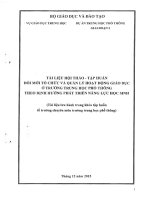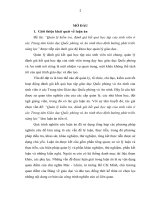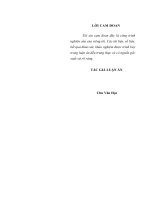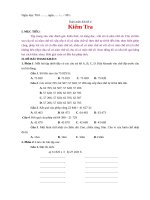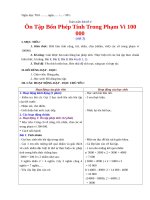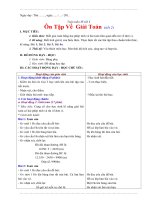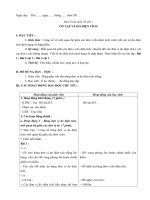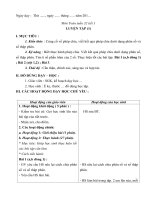giao an moi theo dinh huong phat trien nang luc hoc sinh mon tieng Anh lop 11 hoc ki I
Bạn đang xem bản rút gọn của tài liệu. Xem và tải ngay bản đầy đủ của tài liệu tại đây (591.83 KB, 175 trang )
Unit 1: Friendship
A. Reading (P.1)
The 2nd period
Pre-Date:
Teaching at:
Class
Period
Teaching date
Absent students
Notes
11 A
11 B
I. Objectives:
1. Knowledge, skills and attitude:
- Knowledge: Students should know what a friendship is, know how to keep a friend long.
- Skills: Guessing meaning in context, scanning for specific information and passage
comprehension.
- Attitude: + To help students get started for unit 1 with topic “Friendship”.
+ To provide students some motivation.
2. Developing efficiency:
- Thinking, brainstorming
- Work in pairs, groups
- Communication
- Co-operation
- Self – studying
- Self – management
- Problem – solving
3. Method: Integrated, mainly communicative.
II. Preparation of Teacher and Students:
1. Teacher: Teaching aids, text book, lesson plan.
2. Students: textbook, notebook,..
III. Procedure:
A. Class organization: 1 minute
B. Warm – up activity: 5 minutes
- Ask students the questions:
+ Have you got many friends?
+ Who is your best frriend?
+ What do your friends and you do in your free time?
- Let students understand more about activities and qualities of friends, then say to students:
Today we learn Unit 1- part A: Reading.
C. New lesson:
Content
Teacher’s activities
Students’ activities
I. Before you read: (12’)
- Ask students to look at - Look at the picture in
1
- Look at the picture and read
the poem in the textbook.
- Answer the T’s question.
+ What do you think of the
friend in the poem?
the picture and read the
poem in their books.
- Ask students to discuss
then ask and answer the
question:
the book, listen to the
teacher, read the poem
then ask and answer the
question, work in pairs:
A: What do you think
of the friend in the
-Let them work in pairs.
poem?
- Listen to students and B: I think….
correct pronunciation and
grammar if necessary.
- T may give some - Listen to the teacher.
comments
and
her
suggestion: The friend in
the poem is very dedicated
and thoughtful. He / she is
willing to help his / her
friend
in
any
circumstances.
- Show students to know
about friends.
II. While you read: (26’)
- Read the passage in silence.
- Take note the vocabulary.
- Lasting (adj) = lifelong
(adj) : existing or continuing
a long while (bền vững, lâu
dài )
- To be concerned with :
quan tâm tới ai
- Constant (adj): happening
all the time or repeatedly,
that doesn’t change (thường
xuyên, không thay đổi)
- Constancy (n): sự không
thay đổi
- Rumour (n): piece of
information, or a story, that
people talk about, but that
may not be true ( tin đồn)
- Gossip (n): informal talk or
stories about other people’s
private lives, that may be
- Ask students to look
through the passage and
read in silence.
- Help students read the
passage.
- Explain pronunciation and
meaning of new words
which appear in the
passage.
Pre- teaching Vocabulary
Note : T should only teach
the words which do not
appear in Task 1 .
2
- Listen to the teacher
then read the passage.
- Ask some new words
if necessary.
- Ask sts copy the new
words
- Listen and repeat
unkind or not true (chuyện
tầm phào)
- Trust (n): the belief that
SO/STH is good, sincere,
honest, etc... and will not try
to harm or trick you (sự tin
tưởng)
- Sorrow (n): a feeling of
great
sadness
because
something very bad has
happened (sự đau khổ)
- Pursuit (n): something that
you give your time and
energy to, that you do as a
hobby (sự theo đuổi, đam
- Read new words in
mê)
- Ask sts read new words
chorus
in chorus
- Stand up and read in
- Call some sts read them
front of the class
in front of the class
Scanning
and
- Based on new words,
skimming the passage.
skimming and scanning
the passage.
- Help sts understand the
passage
D. Homework: (1’)
- Ask students to read passage about their friendships
- Ask students to prepare the exercise at home.
IV. Draw up experience:
…………………………………………………………………………………………………
………………………………………………………………………
Unit 1: Friendship
A. Reading (P.2)
The 3rd period
Pre-Date:
Teaching at:
Class
Period
Teaching date
11 A
11 B
3
Absent students
Notes
I. Objectives:
1. Knowledge, skills and attitude:
- Knowledge: Students should know what a friendship is, know how to keep a friend long.
- Skills: Guessing meaning in context, scanning for specific information and passage
comprehension.
- Attitude: + To help students get started for unit 1 with topic “Friendship”.
+ To provide students some motivation.
2. Developing efficiency:
- Thinking, brainstorming
- Work in pairs, groups
- Communication
- Co-operation
- Self – studying
- Self – management
- Problem – solving
3. Method: Integrated, mainly communicative.
II. Preparation of Teacher and Students:
1. Teacher: Teaching aids, text book, lesson plan.
2. Students: textbook, notebook,..
III. Procedure:
A. Class organization: 1 minute
B. Check the old lesson: 5 minutes
- T calls 2 sts go to black board to write the new words
- Call the others give the comment
- T checks and give the marks.
C. New lesson: 28 minutes
Content
Teacher’s activities
Students’ activities
- Read the passage again and - Ask sts read the passage - Read the passage
do all the tasks in text book. again
again
* Task 1: Fill each blank
Task 1 :
- Keep the book open.
with a suitable word/phrase: - Ask students to fill each - Listen to the teacher
Keys:
blank with a suitable then do task 1.
1-mutual;
word/phrase.
- Ask the teacher if
2-incapable of;
- Let students work necessary.
3-unselfish;
individual or in groups.
- work individual or in
4(1)-acquaintance; 4(2)Help
students
if group.
friend;
necessary.
- Write down the true
5-give-and-take;
keys in the notebook.
6-loyal to;
7-suspicious.
* Task 2: Choose which of
Task 2:
- Listen to the teacher.
choice A, B, C or D most
- Ask students look - Look through the
4
adequately sums up the ideas through the passage then
of the whole passage.
try to choose which of the
Key: B
choices A, B, C, or D most
adequately sums up the
ideas of the whole
passage.
- Let them work in pairs.
* Task 3: Answer the
questions.
- Answer key:
1/ The first quality for true
friendship is unselfishness..
2/Changeable and uncertain
people are incapable of …
3/ the third quality for
friendship is loyalty…
4. There must be mutual
trust
between
friends
because if not, people cannot
feel safe when telling the
other their most intimate
secrets.
5. People can’t keep a friend
long because they can’t keep
a secret, either of their own
or others.
6. The last quality for true
friendship is sympathy. It
tells us that to be a true
friend, you must sympathize
with your friend. Where
there’s no mutual sympathy
between friends, there’s no
true friendship
Task 3:
- Ask students to scan the
passage and answer the
questions:
- Let them work in pairs.
- Walk round and help
students.
- Ask some students to
stand up to ask and answer
each other.
Walk
round
the
classroom and correct
mistakes.
passage again and try to
choose
the
most
adequately sums up the
idea of the whole
passage.
- Practice with a partner
then write the key down
in the note book.
- Ask the teacher if
necessary.
- Listen to the teacher
then ask and answer the
questions in the book.
- Stand up to answer the
questions.
D. Practising activities: 10 minutes
* After you read:
After you read :
- Listen to the teacher.
- Discuss the questions.
- Ask students to discuss - Try to discuss the
Questions:
the questions:
question.
5
1. Why do we need to have
close friends?
2. What quality of friendship
is the most important to you?
Why?
Cues:
• share interest, feelings,
sorrow and happiness
• help us out of
difficulties
• empathize with you in
bad times
• confide in him/her
Suggested answers:
1. We need to have friends
because friends are the
people we can trust and
share our interests, feelings,
sorrows and happiness with,
and who completely
sympathize with us
2. In my opinion, loyalty is
the most important because
those are easily influenced
by rumors can never be good
friends.
1. Why do we need to
have close friends?
2. What quality of
friendship is the most
important to you? Why?
- Let them work in pairs.
- Ask them to report the
results to the class
- Listen to students and
correct mistakes.
- The students who are
called to stand up to
report the result to the
class loudly.
E. Homework: (1’)
- Ask students to write a passage about their friendships (80 words)
- Ask students to do Reading exercise of Unit 1 in workbook and prepare Part B : Speaking
at home IV. Draw up experience:
…………………………………………………………………………………………………
………………………………………………………………………
Unit 1: Friendship
B. Speaking
The 4th period
Pre-Date:
Teaching at:
Class
Period
Teaching date
Absent students
6
Notes
11 A
11 B
I. Objectives:
1. Knowledge, skills and attitude:
- Knowledge: Students learn about physical characteristics and personalities of a person and
words related to people’s physical characteristics and personalities.
- Skill: talking about people’s physical characteristics and personalities.
- Attitude: + To help students get started.
+ To provide students some motivation.
2. Developing efficiency:
- Thinking, brainstorming
- Work in pairs, groups
- Speaking,..
- Communication
- Co-operation
- Self – studying
- Creativeness
- Self – management
- Language using
3. Method: Integrated, mainly communicative
II. Preparation of Teacher and Students:
1. Teacher: Teaching aids, text book, lesson plan.
2. Students: text book, note book, ...
III. Procedure:
A. Class organization: 1 minute
B. Warm – up activity: 5 minutes
- Ask students to keep book close
- Ask students to describe some students in the class.
- Call some students stand up to talk to the class.
- Introduce, listen and repair mistakes for students.
(We learn Unit 1, part B- speaking)
C. New lesson:
Content
Teacher’s activities
Students’ activities
I. Pre – speaking: 14 minutes
Task 1: Look at the pictures in Task 1
the text book and describe
- Ask students to look at - Try to repeat from
their physical characateristics the people in the book memory
+ Height: tall, medium, short, and
discribe
their - Try to describe the
…
physical characteristics.
people in the book:
+ Face: square, large, oval, - Let them work in pairs. + The boy is short . He
…
- Introduce “Useful has a large face , …
+ Forehead: broad, high, …
language”
to
the + The girl is ………
7
+ Nose: straight, crooked, ….
+ Hair : Black, grey, ….
+ Appearance: handsome,
beautiful, good-looking, ….
Suggested answers:
1. The boy is about 16 years
old. He may be short-sighted
because he is wearing a pair of
glasses. He has short black
hair, a round face with a broad
forehead, a small nose. He’s
quite good-looking.
2. The girl is about 14. She
also wears a pair of glasses.
She has shoulder-length black
hair. She has an oval face with
a straight nose. She’s rather
pretty.
3. The man is in his forties. He
is tall and well-built. He has
short brown hair and a square
face with a broad forehead,
small eyes, a crooked nose. He
is quite good-looking.
4. The woman is in her
twenties. She’s quite tall. She
has long curly brown hair and
an oval face with a broad
forehead, big eyes, a straight
nose. She is very beautiful.
II. While – speaking: 12
minutes
Task 2: Discuss and number
the following personalities in
order of importance in
friendship.
sincere
square
modest
handsome
understanding
crooked
goodlooking
caring
students.
- Play roles.
-Present
performance.
While-speaking :
Task 2
- Help students with
some new words.
- Ask sts to make
questions and answer
questions with a partner,
using the information
from the picture.
- Let them work in
groups
- Walk round and help
them
8
their
- Work in groups of
four .
List
some
personalities
of
a
person.
- State some reasons
why they choose.
- Discuss and say the
reasons.
- Report their results to
the class and explain
why they do like that..
generous
beautiful
- Ask some students to
stand up to talk again
loudly
- Listen and correct
mistakes
D. Practising activity: 12 minutes
Post-speaking :
Task 3
- Have students work in pairs.
- Guide them to do the task.
- Make sure that sts understand their roles
- Pay attention to the suggestions:
+ his / her name
+ date of birth
+ his / her physical characteristics
+ his / her hobbies
+ his / her personalities ( friendly , humorous , quick-witted , good-natured , helpful ,
honest , pleasant , caring )
+ why he / she interests in Maths
+ how much time he / she spends on Maths everyday
+ what makes him / her a good friend
+ what made him / her successful ( studious , intelligent , keenly interested in Maths , eager
to learn , patient , calm )
+ what he / she does in his / her free time
- Call some pairs to report.
- Walk round and help them
- Ask some students to stand up and tell loudly
- Listen and correct mistakes
E. Homework: (1’)
- Ask students to write a passage about their daily routine (50 words)
- Ask students to prepare Part C- Listening and do homework
IV. Draw up experience:
…………………………………………………………………………………………………
………………………………………………………………………
Unit 1: Friendship
C. Listening
The 5th period
Pre-Date:
Teaching at:
9
Class
Period
Teaching date
Absent students
Notes
11 A
11 B
I. Objectives:
1. Knowledge, skills and attitude:
- Knowledge: Students should know how to describe the best friend and how to keep the
friendship.
- Skills: - To practice listening comprehension skill.
- To distinguish true and false statements.
- To take notes about given questions in order to answer.
- Attitude: + To help students get started.
+ To provide students some motivation.
2. Developing efficiency:
- Thinking, brainstorming
- Work in pairs, groups
- Self – studying
- Self – management
- Problem – solving
- Language using
3. Method: Integrated, mainly communicative
II. Preparation of Teacher and Students:
1. Teacher: Teaching aids, text book, lesson plan.
2. Students: text book, note book, ...
III. Procedure:
A. Class organization: 1 minute
B. Check the old lesson: 4 minutes
- Check the vocabulary to describe physical characteristic and personalities
C. Warm – up activity: 4 minutes
- Ask students to close the books
- Ask students some questions about friendship:
+ Who is your best friend?
+ What qualities & characteristics of your best friend do you admire?
D. New lesson:
Content
Teacher’s activities
Students’
activities
I. Before you listen: 8 minutes
Before you listen:
Ask and answer the questions:
- Ask students to look at - Listen to the
1. Who is your best friend?
the part: Before listening teacher then and
2. How did you happen to meet him - Let them work in pairs answer
the
or her?
ask and answer the questions in the
10
3. How long have you known each
other?
4. What qualities do you admire in
your best friend?
questions:
1. Who is your best
friend?
2. How did you happen
to meet him or her?
3. How long have you
known each other?
4. What qualities do you
admire in your best
friend?
- Walk round, listen and
help students
- Read loudly the words
* Pre-teach vocabulary:
in the books:
- give sb a ring = phone sb
: gọi - Ask students to repeat
điện (synonym)
loudly the words
- rough time [= difficult time: lúc
- Listen and check
gian khó (synonym)
pronunciation
- go through: trải qua, hoàn thành -Explain
some
new
(translation)
words & phrases
- apartment building (n): chung cư
(picture)
- residential
(adj) : dân cư
(explanation)
* Listen and repeat:
apartment building
guitarist
motorbike
sense of humour
favourite
around
book.
- Work in pairs.
II. While-listening: 19 minutes
Task 1: Listen and dicide whether
the state ments are true of false
Lan’s talk
1. F (They used to live in the same
building there)
2. F (It is what people think)
3. T
4. F (Lan went to Do Son first and
-Students read
task1, 2 silently
for gist
While-listening:
-Have students read the
true-false statement list
and questions in textbook
silently
for
several
minutes to make sure that
every
student
understands them (Task1,
2)
11
- Look at the
books
- Listen to the
teacher
and
repeat
the
words.
-Students repeat
& take notes
- Repeat loudly
the words and
try to remember
them
-Students
in pairs.
work
-Elicited
students
raise
their hands to
then called Ha, so Ha rode on her
motorbike to Do Son to meet Lan)
5. T
6. F (They have been best friends
since Lan’s trip to Do Son)
Long’s talk
1. F( They met in college)
2. F ( Minh was a guitarist)
3. T
4. T
5. T
2. Task 2: Listen again and note
down the ideas in the table below.
11A5: Listen and complete the
table (p.18)
* Keys:
How and
What do
where did
they like
they meet? about their
friends?
Lan - They used - Ha’s very
to live in the friendly and
same
helpful
apartment
- Ha’s
building in
sociable.
HN
She’s got
- Lan went
many friends
on a holiday in Do Son
in Do Son
and she
and Ha went introduced
there to help Lan around.
her
Lon - They met
- Minh has a
g
in college
sense of
- Minh
humour
played the
- Minh likes
guitar, and
to go to
Long was a plays and
singer
movies
- They
- Minh is a
worked
good
together
listener
- Minh is
friendly and
helpful
-Check again if students
are able to understand
main requirements of the
2 tasks
-Emphasize “ you will
hear Lan & Long talk
about
their
best
friends_Ha & Minh.
Listen to their talks and
do the tasks below”.
-Turn on the cassette
player twice.
-Ask some students to do
their tasks on the board.
-Correct and give score
12
interpret.
-Students take
notes
during
listening.
-Other students
watch and give
comments.
E. Practising activity: 8 minutes
III. Post listening: Talk about your best friend.
Use the cues below:
- Your friend’s name
- How long have you known each other
- Where and when did you meet
- Your friend’s personalities
My best friend is ……….I happened to meet him when……….in the street. At that time I
got a traffic accident and ………..He is very kind to me that is the thing I like him best.
F. Homework: (1’)
- Ask students to rewrite their answers of tasks 2 in their notebooks at home
- Remember them to prepare Part- Writing at home
IV. Draw up experience:
…………………………………………………………………………………………………
………………………………………………………………………
Unit 1: Friendship
D. Writing
The 6th period
Pre-Date:
Teaching at:
Class
Period
Teaching date
Absent students
Notes
11 A
11 B
I. Objectives:
1. Knowledge, skills and attitude:
- Knowledge: Students learn how to write a paragraph to describe someone’s physical
characteristics and someone’s personalities.
- Skill: Writing a paragraph.
- Attitude: + To help students get started.
+ To provide students some motivation.
2. Developing efficiency:
- Thinking, brainstorming
- Work in pairs, groups
- Knowledge of English
- Co-operation
13
- Self – studying
- Creativeness
- Self – management
- Language using
3. Method: Integrated, mainly communicative
II. Preparation of Teacher and Students:
1. Teacher: Teaching aids, text book, lesson plan.
2. Students: text book, note book,...
III. Procedure:
A. Class organization: 1 minute
B. Check the old lesson: 4 minutes
- Call 2 sts to describe their best friend (physical characteristic and personality)
C. Warm – up activity: 4 minutes
- Ask students to keep book close
- Ask students some questions about their best friends.
D. New lesson:
Content
Teacher’s activities
Students’ activities
I. PRE-WRITING: 7 minutes Pre-writing:
Task 1: Read the following
Comprehension
passage, then answer the
questions
questions.
- T asks Ss to complete
My best friend is Hoang. I first the invitation letters by
meet him when we played for using expressions in Task
the school football team. And 1.
he’s also my neighbour. He will - Ss work in pairs to do
be seventeen on his next Task 1
-Students write a
birthday. He’s living at 124 - T asks Ss to write the
passage.
Nguyen Hue Street his parents. answers on the board and
He’s tall and well-built. He has checks them with Ss.
got a square face, black curly - Ss write the answers on
hair, brown eyes and dark skin.
the board.
We have been good friends - T does correction
since we were little boys. And
we have a lot in common. For
example we both like rock and
we’re crazy about soccer. We
play soccer whenever possible!
We also like fast food and
computers games. We both are
humorous and sociable.
However, there’s something
different between us. I work
hard at school because I want to
14
go to university, but he’s a bit
lazy. His dream is to be a rocker,
not a white-collar worker.
*Answer the questions.
a. What is the writer’s friend’s
name?
b. How old is he?
c. Where does he live?
d. When did the writer meet his
friend?
e. What are his physical
characteristics?
f. What are his personalities?
g. What does the writer like
about him?
Read the passage about Lan’s
friend and answer the
questions below
Lan’s best friend is Hoa. They
became friends when they
attended high school in 2005.
Lan is 17 years old and Hoa is
16 years old. Hoa lives with her
family in a small house in Binh
Hoa Ward. Hoa is tall. She has
got an oval face, a straight nose,
and a black-long hair. She is
very friendly and helpful. Lan
likes Hoa because she always
helps the others without thinking
about her benefit.
-Students read / write
some
students’passsages on
the board.
• Who is Lan’s best friend?
• How old is she?
• How did Lan happen to
meet her?
• What are her physical
characteristic?
• What
are
her
personalities?
• What qualities does Lan
admire in her best friend?
Answer key:
15
1. Hoa
2. 18 years old
3. At school
4. She has got an oval face, a
straight nose, and a black-long
hair.
5. Friendly and helpful.
6. She always helps the others.
II. WHILE-WRITING: 21
minutes
Task 2: Base on the passage
above write a passage about
your best friend using cues
The outline for describing a
friend:
- General information about their
friend
+ Who is he/she?
+ How old is he/she?
+ Where does he/she live?
+ Where/ When did you meet
at the first time? (at a party/ at a
football match / at English club/
in school extra-activities)
His/
her
physical
characteristics and personalities:
+ Personalities: studious,
hospitable, honest, modest,
generous, sincere…
+ Physical characteristic:
•
height: tall, medium,
short,…
• face: square, large, oval..
• forehead: broad, narrow,
high, short….
• nose: straight, crooked…
• hair: black, grey, wavy,
curly…
•
appearance: handsome,
beautiful….
- What Ss like about the friend.
Sentence Building
Group work
- T gets ss to work in
- Work in groups
groups in which each
- Write a paragraph in
group write a paragraph. group
- Ss work in groups.
- T moves around to help
Ss.
- Ss give answer.
- T checks and corrects.
- Ss take note.
16
Notes: Tense: + simple present
tense; simple past tense ( past
habit); used to…
Ex: My friend is……….I met
her at…………
• Write about a friend, real
or imaginary, using the
prompts below:
My friend / name/ Nam. He/
sixteen/ old. Now/ he / live/ his
parents/ a small house/ the
suburbs / Ho Chi Minh City, /
ten kilometres/ the city centre.
We / friends when I/ attend this
school / 2004.
He/ height/ hair. He/
forehead / eyes. He/ always
/well-groomed/ his family/ poor.
Nam/ very helpful/ modest.
When I / into trouble, especially,
he always/ a helping hand. This/
the reason/ everyone in my
class/ in the whole school like/
play/ him.
E. Practising activity: 7 minutes
III. POST-WRITING:
Exhibition and Correction
Sample writing:
My best friend is Hien.
She is 24 years old. She lives in
Thoai Son. I first met her when I
first came to AG university. Hien
is beautiful. She is average
height. She has long black hair,
and a little square face with
black eyes, a straight nose. She
likes wearing Jeans and T-shirt
or sweater. She likes to listen to
music and go out with friends.
Hien has a good sense of humor.
Everyone wants to talk to her
whenever they meet her. Besides,
Correction
Pair work
- T asks Ss to work in
pairs to share and
compare their works.
- Ss check partner’s
writing.
- T corrects and gives
feedback.
17
- Work in pairs
- share and compare
the work
she is very helpful. She is ready
to help me whenever I have
difficulties. That is the thing I
admire her best. I hope that we
will be friends forever.
D. Homework: (1’)
- Ask students to do part writing of Unit 1 in the student’s work book and prepare part
Language Focus
IV. Draw up experience:
…………………………………………………………………………………………………
…………………………………………………………………
Unit 1: Friendship
E. Language Focus
The 7th period
Pre-Date:
Teaching at:
Class
Period
Teaching date
Absent students
Notes
11 A
11 B
I. Objectives:
1. Knowledge, skill and attitude:
- Knowledge: Students should know how to use Infinitive with to or without to to make
sentences.
- Skill: Writing sentences with infinitives with to or without to.
- Attitude: + To help students get started for unit 1 with topic “Friendship”.
+ To provide students some motivation.
2. Developing efficiency:
- Knowledge of English
- Co-operation
- Self – studying
- Creativeness
- Self – management
18
- Problem – solving
- Language using
3. Method: Integrated, mainly communicative
II. Preparation of Teacher and Students:
1. Teacher: Teaching aids, text book, lesson plan.
2. Students: text book, note book, ...
III. Procedure:
A. Class organization: 1 minute
B. Check the old lesson: 4 minutes
- Call 2 sts write their writing on the board.
- T checks and gives mark
C. Warm – up activity: 4 minutes
- Ask students to keep book close
- Ask students to complete the sentence:
- January is the …month of ....year.
- Children..... eating sweets.
- Ask students to speak the sentence loudly
- Let students to get their attention on pronunciation: / dʒ /- / t∫/
- Introduce new lesson
D. New lesson:
Content
I. Pronunciation /ʤ/ and /t∫/: 8
minutes
Listen and repeat
/ʤ / - / ʧ /
jam
dangerous children
mutual
joke
passenger
changeable
church
January village
cheese
which
Teacher’s activities
- T models and asks Ss
to repeat.
- Ss practice the words
with T’s model. One S
reads three words.
- T models each
sentence and Ss repeat.
- T asks Ss to underline
the words that have the
Practise reading aloud the sounds.
dialogue.
Individually
1. Just outside the village, there’s a - T asks ss to compare
bridge.
the answer in pairs
2. Jane always enjoys George’s
- T gives feed back
jokes.
3. Two jeeps went over the edge of
the bridge.
4. Which picture do you think the
child wants to change?
19
Students’ activities
- Listen and repeat.
- Work individually
to underline the
words that have the
sounds.
Compare
the
answer with partner.
5. Mix the mushrooms, chili and
cheese.
6. Do you like French salad and
fish and chips?
II. GRAMMAR: 19 minutes
• Infinitive with To (V- TO)
Ex: Why do you study English?
→ I study English to
communicate with foreigners.
=> Infinitive with To: is used to
express a purpose or placed after
an adjective.
- As object of some verbs: agree,
arrange, begin, care, choose, ask,
come, continue, decide, want,
need, promise, try, seem, start…
- Answer for the structure “What
…for?” and “Why…?”
- After adjectives: pleased, happy,
lucky, hard, easy, difficult,
important, sad,…
- After Wh-words: (where, what,
when, …)
- After “nothing, something,
anybody, nowhere,..”
- After “too…to, enough…to, in
order to, so as to”
- After structure “S + V + O + to
inf” (verbs: ask, advise, …)
2. Infinitive without To (VTO)
- After modal verbs: will, can,
could, should, had better…
- make, let, have
- see, feel, watch, hear, notice, find,
observe, perceive (point at the
completion of the action)
- Sau các động từ khiếm khuyết:
can, could, may, might,...
- help + O + V0/ to V0
Ex 2: Vicky helps me choose a
present.
to choose a
- T gives the example,
- Listen and take
then elicits the form and note
usage of “ infinitive
with to”
- T explains more
clearly.
- Ss listen and take
notes
- Work individually
Sentence building
- Present in front of
- T runs through asks Ss the class
to do the task
20
present.
Practice 1:
Exercise 1: Rewrite the sentences,
using the words given
Ex: - She/ have/ a/ train/ catch.
She has a train to catch.
1. Who/ want/ eat/ something?
2. I/ have / some letters/ write.
3. I/ delighted/ hear the news.
4. My mother / have / some
shopping/ do.
5. You/ always/ have/ too much/
talk about.
6. It/ be/ lovely/ see/ you/ again.
7. It/ be/ too/ cold/ go/ out.
8. I/ be/ happy/ know/ that/ you/
have/ passed/ the exams.
Answer keys:
1. Who wants to eat something?
2. I have some letters to write.
3. I am delighted to hear the news.
4. My mother has some shopping
to do.
5. You always have too much to
talk about.
6. It’s lovely to see you again.
7. It is too cold to go out.
8. I am happy to know that you
have passed the exams
Exercise 2: (page 21) Rewrite the
sentences, using the words given
in brackets.
Answer keys:
1. The police watched them get out
of the car.
2. They let him write a letter to his
wife.
3. I heard them talk in the next
room.
4. The customs officer made him
open the briefcase.
5. The boy saw the cat jump
through the window.
individually in 6ms
- Ss follow instruction
- T calls some Ss to
present their answers.
- Ss stand up and say
out their answers.
- T corrects and gives
feedback.
- Ss take note
- Listen to T
- Work individually
- Compare the
answers with friends
- T elicits the
instruction, does the
first sentence as model.
- T asks Ss to work
individually, then
compare the answers
with their friends.
- Ss do the exercise.
compare and give the
answers.
- Ss write the answers
on the board
- T gives correction
- Ss take note
21
6. Do you think the company will
make him pay some extra money?
7. I felt the animal move toward
me.
8. Do you think her parents will let
her go for a picnic?
E. Practising activities: 8 minutes
Complete the sentences with the correct form of the verb in brackets.
1. I didn’t have enough time
(finish) my work yesterday.
2. He refused
( allow) her
( think) for herself.
3. I was relieved
(find out) that I had passed the exam.
4. She made her son
(wash) the windows before he could go outside
(play) with his friends.
5. She lets her children
(stay) up very late.
6. We had nothing
(do) except look at the cinema posters.
7. We both heard him
(say) that he was leaving.
8. It made him angry
(wait) for people who were late.
9. I couldn’t understand what the passage said, so I had my friend
(translate) it for
me.
10. It’s important
( start) the meeting on time.
D. Homework: (1’)
- Ask students to do Part Language Focus and prepare part Reading of Unit 2 at home
IV. Draw up experience:
…………………………………………………………………………………………………
………………………………………………………………………
Unit 2: PERSONAL EXPERIENCES
A. Reading
The 8th period
Pre-Date:
Teaching at:
Class
Period
Teaching date
Absent students
Notes
11 A
11 B
I. Objectives:
1. Knowledge, skill and attitude:
- Knowledge: Through this unit, students know how to write about the sequence of events in
a story, sentences and expression for describing the sequence of events in a story and words
related to sequence of events in a story.
22
- Skill: - Guessing meaning in context.
- Passage comprehension.
- Attitude: + To help students get started.
+ To provide students some motivation.
2. Developing efficiency:
- Thinking, brainstorming
- Work in pairs, groups
- Knowledge of English
- Speaking, reading,..
- Co-operation
- Self – studying
- Self – management
- Problem – solving
- Language using
3. Method: Integrated, mainly communicative
II. Preparation of Teacher and Students:
1. Teacher: Teaching aids, text book, lesson plan.
2. Students: text book, note book, ...
III. Procedure:
A. Class organization: 1 minute
B. Check the old lesson: 4 minutes
- Call 1 st check the theory of To- infinitive and bare infinitive.
- Check the exercise in part E. Practise exercise of Unit 1: Part E. Language focus.
C. Warm – up activity: 4 minutes
- Ask students about their personal experiences?
D. New lesson:
Content
Teacher’s activities
Students’
activities
I. Before you read: 8 Before you read:
minutes
- Ask students to put the - Put the pictures in
- Put the pictures in the book pictures in the book in the the book in the
in the correct order to make a correct order to make a correct order to
story.
story. (work in pairs)
make
a
story.
- Key : d, b, f, e, a, c
- Ask some students to give ( work in pairs)
their answers.
Give
their
( teacher doesn’t need to answers
give feedback)
- Let’s begin our lesson
you’ll know the whole
story.
- Listen to the tape
- Ask students to listen to
the tape
II. While you read: 20
While you read:
- Read the story
23
minutes
- Some difficult words and
structures
1. embarrass(v)
- embarrassed(adj)
- embarrassing(adj)
- embarrassment(n)
2. idol (n)
3. glance(n/v)
- glance at sb/sth
4. Be busy doing sth
Be busy with sth
EX: I’m sorry. I can’t go with
you now. I am busy with my
homework. I’m busy doing
my homework.
5. note (n) banknote
EX
Do you want the money in the
notes or coins?
- The Beatles were the pop
idols of the 60s.
Task 1 :
Key:
• glanced
• makes a fuss
• embarrassing
• idols
• sneaky
Task 3 : Answer the
questions in the book.
Suggested answers:
1. She wished to have a red
hat-a floppy cotton hat ( like
the one her star idol wore in
her video clip)
- Ask students to read the
whole story
- Explain some difficult
words and structures
- Listen, try to
guess the meaning
of the new words
and take notes
Task 1 : Fill each blank
with one of the words in the - Do Task 1 in
box below.
pairs
- Firsly, ask students to - Take notes
study individually then in
pairs
- Walks arround the class,
offer ideas and comments
when students need help
- Give suggesstions
Task 2 ( Đã lồng vào
before you read)
Task 3 : Answer the
questions in the book.
- Ask students to read all
questions to understand the
content
- Ask students to read the
small talks again to answer
the questions
- Ask students to work with
24
Read
the
questions silently
and answer them in
groups
- Give the answers
2…...so that she could buy the a partner
hat ( for herself.)
- Walks around the class to
3. She saw a wad of dollar help students whenever they - Take notes
notes ( exactly like the one need
that her father had given her).
4. Because she thought the
boy had stolen her money / it
was her money.
5. She bought the pretty hat of
her dream.
E. Practising activities: 7 minutes
-Ask students to discuss the questions in group and represent their talk in front of class
1. How did the girl in the story feel when she discovered that the money she had taken was
not hers?
(embarrassed, sad, ashamed, unhappy, terrible, uncomfortable, anxious, …)
2. What did the girl have to do (when she discovered that the money she had taken was not
hers )?
(put a notice on T.V or at school, get on the same bus on the next day to look for him, do
nothing, keep it a secret, tell her father everything and ask him for advice,…)
D. Homework: (1’)
- Ask students to review part reading and do exercises in the workbook and prepare part
speaking
IV. Draw up experience:
…………………………………………………………………………………………………
………………………………………………………………………
Unit 2: PERSONAL EXPERIENCES
B. Speaking
The 9th period
Pre-Date:
Teaching at:
Class
Period
Teaching date
Absent students
Notes
11 A
11 B
I. Objectives:
1. Knowledge, skill and attitude:
- Knowledge: Through this unit, students can talk about their personal experiences.
- Skill: Talking about past experiences and how they affected one’s life.
- Attitude: + To help students get started.
25

